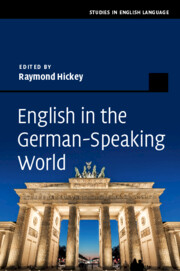Book contents
- English in the German-Speaking World
- Studies in English Language
- English in the German-Speaking World
- Copyright page
- Contents
- Figures
- Tables
- Contributors
- Preface
- Chapter 1 English in the German-Speaking World: The Nature and Scale of Language Influence
- I The Status of English
- II The Transmission of English
- III Domains and Features of English
- IV Beyond Germany
- Chapter 14 Varieties of English in the Netherlands and Germany
- Chapter 15 English in Austria: Policies and Practices
- Chapter 16 English in Switzerland
- Chapter 17 English and German in Namibia
- Chapter 18 English in German-Speaking Wisconsin and the Aftermath
- Chapter 19 The English ‘Infusion’ in Pennsylvania German
- Index
- References
Chapter 19 - The English ‘Infusion’ in Pennsylvania German
from IV - Beyond Germany
Published online by Cambridge University Press: 11 November 2019
- English in the German-Speaking World
- Studies in English Language
- English in the German-Speaking World
- Copyright page
- Contents
- Figures
- Tables
- Contributors
- Preface
- Chapter 1 English in the German-Speaking World: The Nature and Scale of Language Influence
- I The Status of English
- II The Transmission of English
- III Domains and Features of English
- IV Beyond Germany
- Chapter 14 Varieties of English in the Netherlands and Germany
- Chapter 15 English in Austria: Policies and Practices
- Chapter 16 English in Switzerland
- Chapter 17 English and German in Namibia
- Chapter 18 English in German-Speaking Wisconsin and the Aftermath
- Chapter 19 The English ‘Infusion’ in Pennsylvania German
- Index
- References
Summary
Pennsylvania German (known as Pennsylvania Dutch by most of its speakers) is a North American language that developed in colonial Pennsylvania and is most similar to the dialects of the southeastern Palatinate (Vorderpfalz) (Louden 2016).
- Type
- Chapter
- Information
- English in the German-Speaking World , pp. 384 - 407Publisher: Cambridge University PressPrint publication year: 2019

